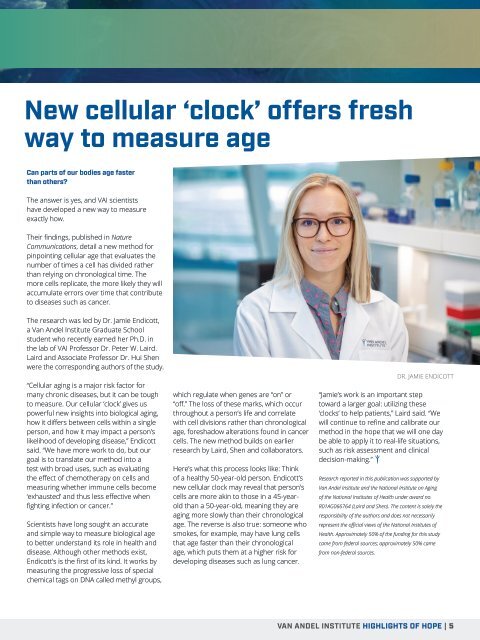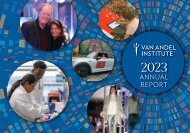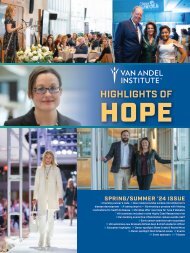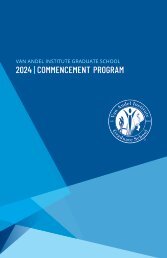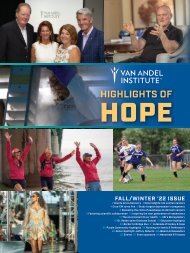Highlights of Hope Spring/Summer 23
This is the 2023 Spring/Summer edition of Van Andel Institute's Highlights of Hope donor publication.
This is the 2023 Spring/Summer edition of Van Andel Institute's Highlights of Hope donor publication.
You also want an ePaper? Increase the reach of your titles
YUMPU automatically turns print PDFs into web optimized ePapers that Google loves.
New cellular ‘clock’ <strong>of</strong>fers fresh<br />
way to measure age<br />
Can parts <strong>of</strong> our bodies age faster<br />
than others?<br />
The answer is yes, and VAI scientists<br />
have developed a new way to measure<br />
exactly how.<br />
Their findings, published in Nature<br />
Communications, detail a new method for<br />
pinpointing cellular age that evaluates the<br />
number <strong>of</strong> times a cell has divided rather<br />
than relying on chronological time. The<br />
more cells replicate, the more likely they will<br />
accumulate errors over time that contribute<br />
to diseases such as cancer.<br />
The research was led by Dr. Jamie Endicott,<br />
a Van Andel Institute Graduate School<br />
student who recently earned her Ph.D. in<br />
the lab <strong>of</strong> VAI Pr<strong>of</strong>essor Dr. Peter W. Laird.<br />
Laird and Associate Pr<strong>of</strong>essor Dr. Hui Shen<br />
were the corresponding authors <strong>of</strong> the study.<br />
“Cellular aging is a major risk factor for<br />
many chronic diseases, but it can be tough<br />
to measure. Our cellular ‘clock’ gives us<br />
powerful new insights into biological aging,<br />
how it differs between cells within a single<br />
person, and how it may impact a person’s<br />
likelihood <strong>of</strong> developing disease,” Endicott<br />
said. “We have more work to do, but our<br />
goal is to translate our method into a<br />
test with broad uses, such as evaluating<br />
the effect <strong>of</strong> chemotherapy on cells and<br />
measuring whether immune cells become<br />
‘exhausted’ and thus less effective when<br />
fighting infection or cancer.”<br />
Scientists have long sought an accurate<br />
and simple way to measure biological age<br />
to better understand its role in health and<br />
disease. Although other methods exist,<br />
Endicott’s is the first <strong>of</strong> its kind. It works by<br />
measuring the progressive loss <strong>of</strong> special<br />
chemical tags on DNA called methyl groups,<br />
which regulate when genes are “on” or<br />
“<strong>of</strong>f.” The loss <strong>of</strong> these marks, which occur<br />
throughout a person’s life and correlate<br />
with cell divisions rather than chronological<br />
age, foreshadow alterations found in cancer<br />
cells. The new method builds on earlier<br />
research by Laird, Shen and collaborators.<br />
Here’s what this process looks like: Think<br />
<strong>of</strong> a healthy 50-year-old person. Endicott’s<br />
new cellular clock may reveal that person’s<br />
cells are more akin to those in a 45-yearold<br />
than a 50-year-old, meaning they are<br />
aging more slowly than their chronological<br />
age. The reverse is also true: someone who<br />
smokes, for example, may have lung cells<br />
that age faster than their chronological<br />
age, which puts them at a higher risk for<br />
developing diseases such as lung cancer.<br />
“Jamie’s work is an important step<br />
toward a larger goal: utilizing these<br />
‘clocks’ to help patients,” Laird said. “We<br />
will continue to refine and calibrate our<br />
method in the hope that we will one day<br />
be able to apply it to real-life situations,<br />
such as risk assessment and clinical<br />
decision-making.”<br />
Research reported in this publication was supported by<br />
Van Andel Institute and the National Institute on Aging<br />
<strong>of</strong> the National Institutes <strong>of</strong> Health under award no.<br />
R01AG066764 (Laird and Shen). The content is solely the<br />
responsibility <strong>of</strong> the authors and does not necessarily<br />
represent the <strong>of</strong>ficial views <strong>of</strong> the National Institutes <strong>of</strong><br />
Health. Approximately 50% <strong>of</strong> the funding for this study<br />
came from federal sources; approximately 50% came<br />
from non-federal sources.<br />
DR. JAMIE ENDICOTT<br />
VAN ANDEL INSTITUTE HIGHLIGHTS OF HOPE | 5


